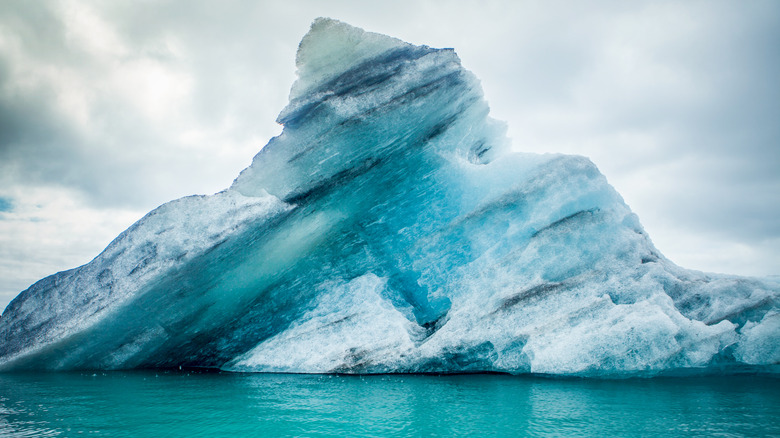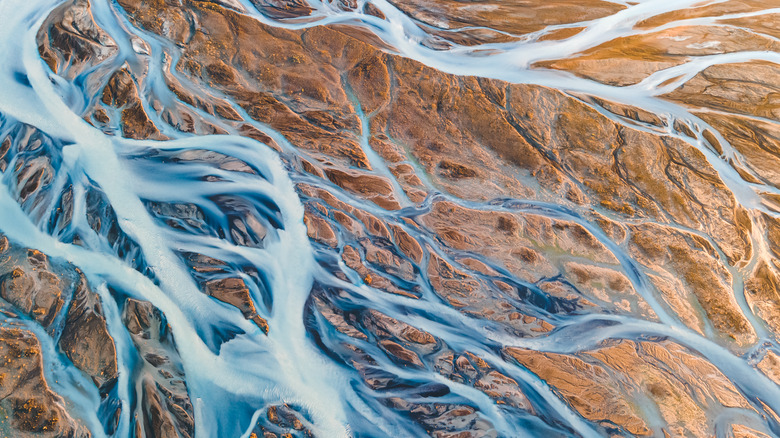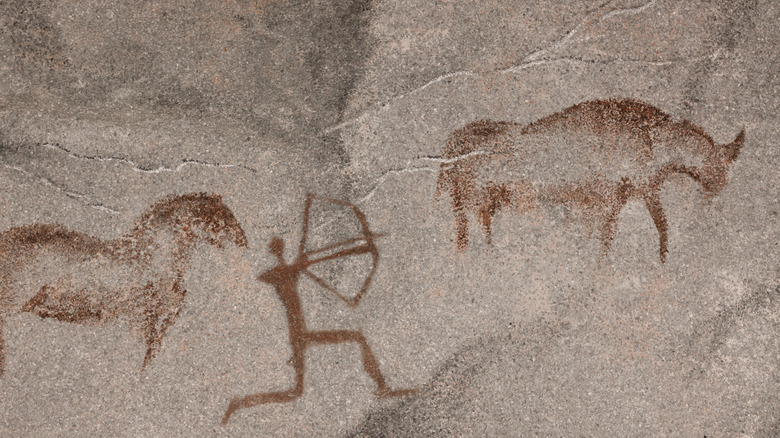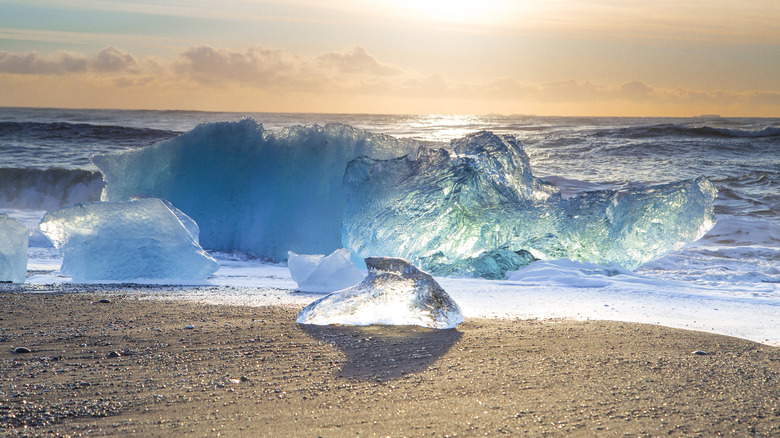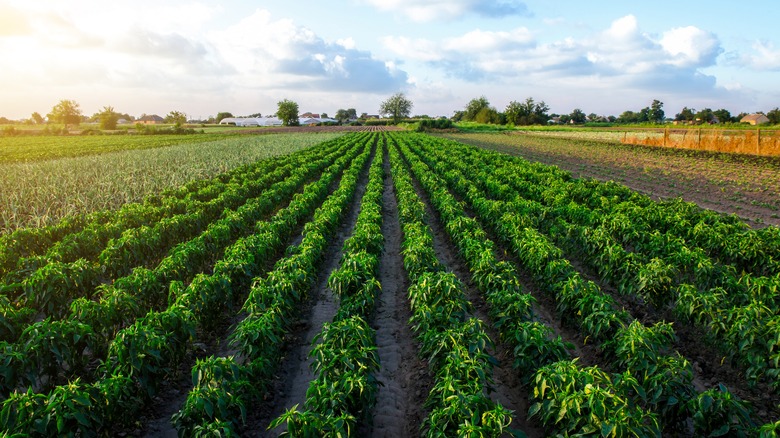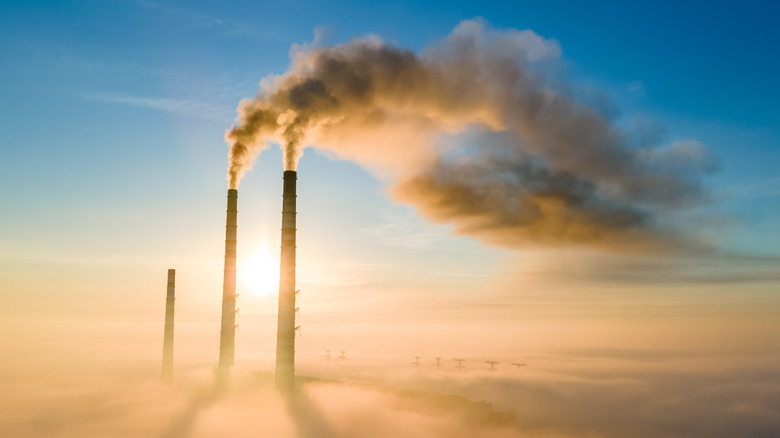What Would Happen If The Earth Had Another Ice Age?
Earth has already been through at least four major ice ages, according to National Geographic — so when is the next big freeze due to happen? Would the next ice age play out suddenly and dramatically, in disaster movie fashion, like "The Day After Tomorrow"? Or would an ice age be so slow-moving that humans could escape from it?
There's no denying that if Earth started having ice age conditions today, we would all be impacted. Firstly, ice ages often last for a really long time, and the most recent ice age spanned about 1.9 million years. Believe it or not, we are actually in the tail end of an ice age right now, with the polar ice caps as the last remnants of the days when the planet's whole surface was ice covered. According to Science Focus, the ice age technically ended about 12,000 years ago, putting the Earth into a phase called the "interglacial period."
How an ice age transforms Earth
Per Discover Magazine, ice ages usually take many years to start, and then end abruptly. It's easy for the Earth to stay chilled for centuries, but it only takes a brief period to heat up. Lots of waterways like lakes and rivers were originally formed as glaciers melted, transforming the rocks around them with the force of the melt-water, according to Live Science.
By digging deep holes in the bottom of the ocean, paleoclimatologists have a pretty clear snapshot of how extreme weather trends affected that area throughout history (via The ABC). After studying the chemical components of rock that is millions of years old, scientists can gain clues to tell us what the prior ice ages were like (via Smithsonian Magazine).
The sun dims during ice ages, so temperatures dropped down as low as negative 58 degrees. These icy temperatures are so dramatic that during previous ice ages, single-celled organisms were the only things that could survive — no humans, animals, and plants could have evolved in these harsh conditions.
How humans survived previous Ice Ages
Per Smithsonian Magazine, the only thing that survived the first few ice ages was a slimy, single-celled underwater algae that formed near hot spots. And that's basically it. Just algae. Scientists think it was simply too cold for multi-celled life to develop for much of Earth's history.
But humans would actually go on to survive one of the more recent ice age periods, which happened between 10,000 to 40,000 years ago (via History). They had to wear fur to keep warm, and used spears and harpoons to hunt big animals that could feed lots of people.
If an ice age suddenly started today, here's what would theoretically happen, per National Geographic. As the Earth cooled, people would begin to move towards the center of the Earth, the equator, where it's usually toasty warm. ABC reports that the scale of human misplacement would be astronomical, with hundreds of millions of people being forced to head to warmer climates. Even for people who wanted to stay, there would be no escaping the accumulating snow and ice. By some estimates, the entirety of North America, Canada, Europe, and northern Asia would be completely covered in thick ice and heavy snow.
Say goodbye to the ocean and hello to land bridges
Folks who lived near the water would find that reality to be no more: as the ice hardened, the ocean would shrink by a lot (via The ABC). People who had waterfront views could find themselves miles away from water as the sea levels shrink by an incredible 400 feet.
Of course, without important areas like the Mediterranean Sea and the Bering Strait, it would be a bit harder to move things by boat. Thanks to all the new land, it would be a lot easier to get around on foot, though. You could theoretically take a walk from Asia to North America, like some of the world's first humans did. According to Smithsonian Magazine, the land bridge between the two continents was home to wooly mammoths and steppe bison, which are now extinct.
The icy conditions would, unfortunately, make the land unusable for farming, according to The ABC. The grim reality is that there would no longer be enough food to go around. Especially with a population size that is about to reach 8 billion people, which is far more humans than have ever lived on Earth before, it seems very unlikely that everyone could have enough to eat (via Worldometer).
Ice sheets thousands of feet thick
According to The ABC, an ice age builds up over dozens of centuries — it never happens suddenly. Snow stops melting and instead forms into huge mounds and enormous ice sheets. As History reports, planet Earth has gone through at least five ice age periods, with the first happening more than 2 billion years ago. During these times, ice sheets could grow exponentially, thanks to the extreme and unending cold. Some ice sheets were 12,000 feet deep.
National Geographic reports that we can look to the "Little Ice Age" of the 16th and 17th centuries for more clues about what it could look like. For these unfortunate folks, even though the average temperature only shifted about three degrees Fahrenheit, glaciers grew to epic proportions that squeezed out the people who lived nearby. It mainly affected crop growth, because the cold limited how well plants could grow. Farmers had to abandon their land because the seasons were just too cold to let their crops grow.
Will there ever be another ice age?
While we are on the precipice of the next ice age, it's all relative, because it definitely won't happen in our lifetimes, per Live Science. We have climate change to thank for that, because the worse climate change gets, the more the timeline of an ice age gets pushed back. The glut of carbon dioxide in our air will make it hard for ice to form, so we probably have at least 100,000 years until the next ice age.
According to NASA, the current climate situation is not looking good for those hoping for an ice age. We may have caused such bad climate change that an ice age will not happen at all for the foreseeable future. As The Conversation reports, ice ages only happen when the amount of carbon dioxide in the air dips below 300 parts per million — and currently, they're hovering around 400 parts per million. So even though an ice age may have technically started around 6,000 years ago, per The ABC, our newest ice age is dead on arrival.
